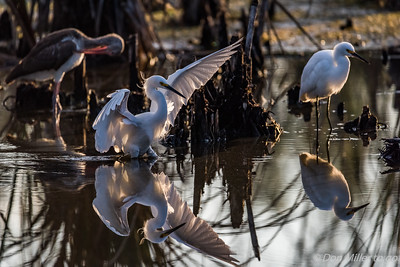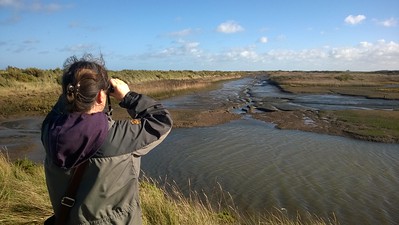Most birders agree that higher magnification and larger lenses don’t necessarily equate to better binoculars for bird watching. When you watch birds, the most important thing you want is a clear view that is true to colour.
So, what is the best magnification for bird watching binoculars? Many newbie birders prefer a pair of binoculars with a magnification range from 7x up to 10x to get the best bird watching results. However, in addition to magnification, you will also want to consider objective lens size, the field of view, image or optical quality. If you wear glasses, you may be interested in options that offer eye relief when searching for a good pair of binoculars.
While all of this may appear a bit complicated at first glance, it’s actually pretty easy if you get a good understanding of binocular basics. This article will teach you everything you need to know to pick a great pair of bird watching binoculars, regardless of your experience.
Binocular Basics
What Do the Optics Numbers Mean?
First things first, when looking to purchase binoculars, one of the main things to keep an eye out for is the optical configuration. Most binoculars clearly label and print these specs right on the side of the body in a numbered format. Understanding these numbers is the first step to choosing a pair suited for your intended viewing excursions.
Optics numbers are formatted with the magnification level listed first and then followed by the objective lens size. This means that a 7×35 optics configuration denotes seven times the magnification level with a 35mm objective lens diameter.
What Binocular Size Is Best for Bird Watching?
The optics numbers can also alert you to the size classification of binoculars. As a general rule of thumb, compact binoculars have objective lenses that are 30 mm or smaller, while medium-sized ones have an objective lens that measures between 30 and 40mm. Anything bigger is considered a large pair of binoculars. Most bird watchers use either medium or compact-sized binoculars, depending on their specific circumstances.

Binocular Magnification and Lenses Explained
What binocular magnification is needed for watching birds?
The ideal magnification on binoculars for bird watching is often considered to be 8x, but 7x and 10x magnifications are also commonly used by bird watchers.
When it comes to bird watching binoculars, you want enough magnification (also called zoom) to allow you to see birds from a distance while maintaining a decently-sized field of vision for context.
If you have too much zoom, you will only be focused on one very small spot. On the other hand, if you don’t have enough zoom, you may not be able to see the birds clearly. That’s why balancing the amount of zoom with the field of view sets you up for ideal viewing conditions.
Is More Magnification Better for Bird Watching?
A higher magnification may sound favourable for close viewing, but more magnification also means a narrower field of view. Generally speaking, it is easier to locate and observe fast-moving small birds using a pair of binoculars with a wider field of view. With a narrower FOV, you will get a closer look at birds, but it will take longer to locate them, and they could very easily have flown off by the time you do.
In addition, you may experience less sharp and less steady image quality with high magnification binoculars.
What Objective Lens Size Is Best for Bird Watching?
Next to magnification, you will also want to consider the size of the objective lenses when choosing bird watching binoculars.
The objective lens allows light into the binoculars, and the size of the lens helps you to determine the amount of light that is being let in. A larger diameter in the objective lens will make images appear brighter because they let more light into the spotting scope than smaller sized lenses.
What Is the Ideal Zoom to Lens Ratio?
Maintaining approximately a 5 to 1 ratio between the lenses and the level of magnification is best for bird watching. Of course, slightly larger lenses will be better for days with low light transmission, like when it is overcast, dusk, or when you are in the dark woods – all of which are quite common when it comes to bird watching.
Additional Binocular Considerations
Image Quality and Bird Watching Binoculars
While magnification level and objective lens size go a long way in image quality, we also recommend that you look for fully multi-coated lenses to get the best bird watching experience from a pair of binoculars. The coatings on the objective lens help prevent moisture build-up and light reflection on the lens’s surface. In addition, they make the lens easier to clean without damaging them.
Choosing a pair of binoculars that is both fog and waterproof can also help improve the image quality in a variety of outdoor weather conditions or if you plan on bird watching near or on a body of water.
The image quality can suffer, too, when you attempt to view birds from a close distance. If you plan on observing in a shorter range, look for binoculars with a close focus distance. Otherwise, birds at a close range will not come into focus.
Eye Relief and How It Affects Eyeglass Wearers
The term “eye relief” refers to the distance between the eyepiece itself and the point where the image comes into focus. This is most important for people who wear glasses.
Eye relief in binoculars is measured in millimetres, and 10 to 15mm is often best for viewing pleasure and comfort overall. But, if you wear eyeglasses, you may need a higher eye relief distance. Eyecups can also interfere with glasses wearers, so looking for options with retractable eyecups could also be beneficial.
Porro vs Roof Prism
Binoculars come with either a roof or Porro prism design. Considering the prism style can also help you fine-tune your decision on which binoculars are best for your needs.
Roof prism binoculars are often lighter in weight and more streamlined in design. The main drawback when it comes to bird watching is that they typically have a narrower field of view, but they are often more weatherproof, so it all comes down to what you think will benefit you most. A roof prism design may also be more expensive.
Porro prism binoculars are wider at one end and narrower on the other. They typically provide you with a wide field of view because they are able to allow more light into the lenses. They are often the more affordable design of the two options as well. The main drawback to a Porro prism design is that they tend to be heavier, leading to less steady images, especially if you are bird watching for extended periods and your arms and hands begin to strain or become tired.
Weight of the Device
The weight of a pair of binoculars can also affect your bird watching experience. Not only it is harder to hold binoculars steady when they weigh more, but they can also tire out your arms and hands quicker. A lightweight pair of binoculars will make it easier to hold them steady, resulting in better image quality overall. As you probably know, bird watching can often take a considerable amount of time, so you will want to make things easier on yourself as far as physical effort is concerned.

What Are the Best Birding Binoculars for You?
Now that you have a basic understanding of binoculars, what optics configuration do you think would work best for you?
As you’ll remember, a 7 to 10x magnification with a lens size approximately five times the magnification is our top recommendation for birding binoculars.
The most common configurations are 7×35, 8×40, and 10×50. An 8×42 optics configuration is also great for watching birds as it lets a bit more light in the spotting scopes and is better in dim light. That’s because even in bright light, you will get a slightly darker image with smaller objective lenses.
Typically, 8x magnification is preferable to 10x if you want a wider field of view, a steadier image, and more eye relief – which is crucial if you wear glasses.
Birdwatching Binoculars Made Easy
What is the best magnification for bird watching binoculars? A pair of high-quality binoculars with an 8×40 rating is often the ideal optics configuration for most bird watchers. However, everyone has their preferences, and there are different viewing circumstances. For example, you may prefer to use a higher magnification with distance birding, like watching birds of prey that fly high in the sky or for waterfowl on the ocean or a lake. Adversely, suppose you plan on observing birds closely, like in a bird sanctuary or aviary. In that case, you will want to pick a pair of binoculars with the ability to focus at a close distance without distorting the image.
Nonetheless, we still recommend bird watchers max out on magnification at 10x. Whichever magnification you choose, just remember to consider the field of view and opt for an objective lens size with approximately a 5 to 1 ratio or slightly larger if you plan to frequently use them in low light conditions. Lastly, if you are a glasses wearer, make sure the eye relief is also accommodating. Keep our information and tips in mind, and you should be all set!
Do you have any other tips on magnification for bird watching binoculars? Let us know your thoughts in the comments below.
Additional Resources
Sam loves to learn about animals and their habitats. He has been a nature lover from a very young age, and has been writing papers and articles about wildlife for as long as he can remember.

Once you really get into binoculars things get more complicated! There is no direct correlation between the binocular magnification, size of the front objective lens and the field of view or brightness of image. Some 7 x 50 binoculars for example, have a very narrow subjective field of view as do the Swarovski Habight 7 x 42s.
Generally a pair of 8 x 32 binoculars will provide a wider field of view than a pair of 8 x 50 binoculars from the same manufacturer. Eye relief is catered for far more now than in the past when most porroprisms had fixed eye cups. My Leica 8 x 32 BAs do not have enough eye relief for me to get a fully illuminated view wearing glasses. I also have a pair of Nikon 8 x 32 HG binoculars which not only have longer eye relief than the Leicas, but also have a wider field of view. However I prefer the colour rendition of the Leicas. My old Nikon 10 x 42 HG bins have massive eye relief but have a slightly smaller subjective FOV than the smaller Nikons.
I can hold high magnification bins still with very little shake and would suggest that heavy bins, my big Nikons weigh over a kilogram, are actually steadier in the hand, as they possess greater inertia, the resistance to being moved! Cheap porroprisms blow cheap roof prisms out of the water, as roof prisms have to be made to much closer tolerances due to the more complex and critical path the light has to travel through each optical system. Better roof prisms have phase correction coatings to absorb rogue wavelengths of light that become out of phase with the rest and cause colour fringing around objects being viewed.
However, I would agree that 7x or 8x magnification binoculars are best for the woods etc. 10 x or even higher magnification bins are best for hides birds of prey and sea viewing. My massive old Zeiss 12 x 50 Nobilems have fantastic optics with a huge field of view. Sadly they have no eye relief, weigh 1250 grams and are extremely bulky. A fascinating subject that I have hardly scratched the surface of in my comments.